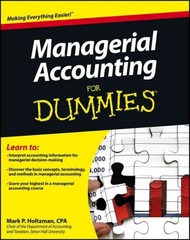Question
the concept of Unified Modeling Language (UML) as a structure model used to document system needs in the implementation of relational databases. UML models can
the concept ofUnified Modeling Language (UML)as a structure model used to document system needs in the implementation of relational databases. UML models can be developed using the R-E-A framework to help identify required resources, events and agents in a business process.
RequiredReview the UML examples in the Glossary of Models starting on page 406 in your text and answer the following questions for discussion: (a) What are common resources, events and agents found in either the sales or purchase process for most businesses? (b) How can the Glossary of Models help you develop a UML model for your current, past or future workplace toward building an AIS?Post your original contribution by Sunday. Respond to at least one other team member by the end of the week with a question or substantive comment about their post.
page 406
ure Models Using the REA Framework
1.SalesGeneric Model
The generic model represents typical economic resources, events, and agents involved in the sales process. This model assumes that inventory items are not tracked individually (like high-value items such as automobiles and houses), but rather by UPC code such that all products with the same UPC code are considered to be the same item.
Page 407
2.SalesWith Invoice Tracking
This model extends the generic model to track the invoices issued to each customer as shown in the association (1) between Customers (Agent) and Invoices (Type Image).
3.SalesWhere Employees Are Assigned to Service Particular Customers
This model extends the generic model to represent assignment of employees to customers. The association (1) links customers to the assigned employee, such as when sales take place on commission. Similarly, employees can be assigned to inventory when specific employees manage specific inventory items.
Page 408
4.Sales with Summary
This model presents a simplified example of the summarization of economic activity by fiscal period in order to prepare financial reports. In this case, sales are summarized by fiscal period as shown in the association (1) between Accounting Summary and Sales.
5.PurchasesGeneric Model
The generic model represents typical economic resources, events, and agents involved in the purchases process. Like the generic sales model, this model assumes that inventory items are not tracked individually, but rather by UPC code or similar identifier.
Page 409
6.PurchasesWith Commitment Event
Thismodel adds the commitment event, Purchase Orders, to the generic model. A commitment precedes the economic event. It records anticipated purchases but does not directly affect the financial statements. Note that this model requires tracking both the items ordered and the items received, which is a level of complication that many organizations avoid. Thus, they use a structure that combines the Purchase Orders and Purchases event as shown in the next model.
7.PurchasesWith Combined Purchase Orders and Purchases
This model shows the combined Purchase Orders and Purchases event (still titled Purchase Orders). The Purchase Order class would track both the date of the order and the date of the receipt of products (the purchase date). The organization is now concerned with only one association between Purchase Orders/Purchases and the Products classes. However, there are now two associations between the Employees and Purchase Orders class, representing the requirement to track the two roles (purchasing agent and receiving agent) separately for internal control.
Page410
8.PurchasesWith Type Images to Manage the Purchases Process
This model shows potential use of two type images to manage the purchase process. The Purchase Status type (1) would summarize information based on the point in the purchase process at the end of a fiscal periodfor example, amounts on order, amounts received, amounts paid. The Purchase Type (2)would summarize information according to the type of purchasefor example, routine organizational supplies and services, inventory replenishment, and asset acquisition.
9.PurchasesWith Type Images Linked for Summary Information
Page 411
This model provides an example of the use of type images to summarize information. In this case, the organization could use the category classes to obtain summary information about supplier characteristics and activity, about product characteristics and activity, and about the common activity for each product and supplier category combination (1). For example, annual sales for each supplier category and product category combination would be recorded in the linking table between those two type images.
Step by Step Solution
There are 3 Steps involved in it
Step: 1

Get Instant Access to Expert-Tailored Solutions
See step-by-step solutions with expert insights and AI powered tools for academic success
Step: 2

Step: 3

Ace Your Homework with AI
Get the answers you need in no time with our AI-driven, step-by-step assistance
Get Started


